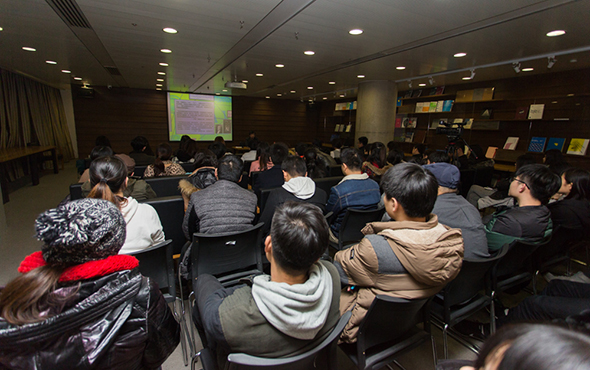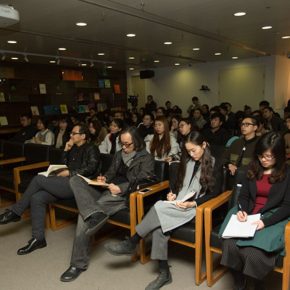
On the evening of January 5, 2017, “Thinking Space” series of academic lectures–Architecture in “Negotiating Space”?was held in the Auditorium of CAFA Art Museum. The speaker was Prof. Zhou Yufang, Director of the Department of Architecture at the School of Architecture, CAFA along with Han Tao, Director of the Department of Graduate at the School of Architecture and they both entered a discourse with Prof. Wang Chunchen, Head of the Department of Curatorial Research of CAFA Art Museum presiding over the dialogue.
Negotiating: Divinity Space and Scaffolding
First of all, Prof. Zhou Yufang started from a personal perspective to view the CAFAM Biennale 2016, and carried out a narrative and discussion on many doubtful issues including the topic of architecture as a practical applied discipline, how to start the architectural teaching in the academy of fine arts, and how to stand in the perspective of art to see architecture, space, city and so on. Closely around the theme of “Negotiating Space”, focusing on the negotiating performance?of the Biennale, researching the origin of negotiation in the history of architecture and expanded the topic of the practice works of the students from the School of Architecture.
“It uses a scaffold in the exhibition, although it is not actually a complex device, it perfectly corresponds with the theme of negotiating space, and it is different from the previous scaffolding model, the conjunction is revealed in the intervention of space, instead of an intention to change the space”. Prof. Zhou Yufang talked about the feelings when he first visited the biennale, “It implants the meaning of growth into the device, which becomes the clue and way to guide the audience to visit it.” This mode of expression also gave Prof. Zhou further thinking, the negotiated space is not the direct change of spatial effects caused by the intervention of the work, but the coordination effect produced by the coexistence of the two, such an effect changes the spatial properties of the art museum, which makes the original single space stimulate a multifold face and state.
The art museum was designed by the Japanese architect ARATA ISOZAKI, “he designed the space which corresponds with the structure of a church, and attempting to offer people the feeling of a divine space.” Therefore, the space of a very strong subjective structure and the negotiating device structure produces a contrast and a dialogue, this dramatic effect is a highlight. Then Prof. Zhou analyzed the “negotiating” pedigree at the entrance to the second floor.
Translation: The Evolution of the Ideological Trend of the Architectural History
Then, Prof. Zhou took the evolution of the ideological trend of the architectural history to introduce the process of thinking of the exploration of some well-known architects and architectural groups to the audience. He first introduced the concept of the Radiant City by Corbusier, and he said that even if we now view this “power-like” concept with a critical eye, it would not be difficult to find we were surrounded by the areas including Wangjing that have already finished the concept of Radiant City.” The Ten Times Group composed of several European architects has criticized the thought of power carried by the Radiant City in the “Present Utopia”, and they stressed that the city should be the existence of the organism, rather than top-down power dominance.
Then, Prof. Zhou also listed the “Nomadic City”, Yona’s “Mobile Architecture”, Archigram’s “Socket City”, “Computer Scale Expansion”, “Euclid-like Original Design”, and some architectural thoughts and conceptual designs by the Japan’s “Metabolism”. He said that, “In the face of reality, these complex ideas and designs were only a “paper building”, to describe a premature, possible reality for people.”
Prof. Zhou then talked about the scene of the September 11 terrorist attacks and briefly described the issue of urban renewal. “The process of reconstruction of New York can be seen as a manifestation of the negotiating relationship between the public and the government with the architect.”
Criticism: Interventional Means of Negotiating Space
In the third part of the sharing, Prof. Zhou took the actual architectural cases to interpret the negotiating space as a means of intervention and its possible effect that might be produced. It focused on two cases, the first one was Lebbeus Woods who designed an alien sculpture to break the absolutely rational grid-net building of the Raffles Place in Chengdu created by Steven Holl, to form a new discussion, this is a typical critical spatial intervention, the concept of communication is clear at a glance. Koolhaas designed a work challenging the classic transparent box designed by Mies in the IIT (Illinois Institute of Technology) which is also a typical case of spatial intervention, in which the original complete rational order is separated?and diagonal using curved buildings. Prof. Zhou Yufang explained, “It is actually a means of intervention, a way of dialogue”. After sharing several famous architectural cases, Prof. Zhou showed the audience another interpretation of spatial intervention from the perspective of works of students from the School of Architecture.
In the section of dialogues with the guests, Han Tao first expressed the view of the negotiating space of the Biennale, and he believed that the scaffold was very different from the past, “it is the materialization of a concept at this time, the use of landscape and framework rather than a strong state of an object to create an atmosphere” and it includes the infinite two-dimensional code and books, all things coexist, the time is present, things and the audience are having a mutual dialogue.
The dialogue was closely formed around negotiating the space to carry out the exhibition and it finally returned to the topic of the Biennale, Han said that, “Cancelling the curator is like cancelling the subject of the absolute power, and participants of the negotiating dialogue which become pluralist, multi-subject replacement of the single-subject structure.” Then he explained that, “Negotiation seems a long process, the extension of time changes the fractional patterns of physical space, although the things which have experienced the negotiating process are not necessarily reflecting a complete and coordinated appearance, though seemingly complete, rational constructions are a way of expressing power.”
Negotiating Space connects the transfer of rules, while focusing on aesthetics?too much emphasis on the power and this reinforces the single manifestation, and multi-subject means to be used by more people, shared by more people. “A good exhibition is the process of producing knowledge, which helps us to understand the present state of life and in the future architects may be coordinators.”
Prof. Wang Chunchen concluded that the lecture had gone beyond the previous discussions on pure art as the core and deep and wide-ranging ideas were presented. It was also hoped that the future exhibition of the museum would lead to more interesting and diversified thinking.
Text by Zhang Yizhi, translated by Chen Peihua and edited by Sue/CAFA ART INFO
Photo by Yang Yanyuan/CAFA ART INFO
(some of the photos are from the internet)





































